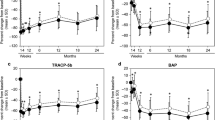Summary
In patients who have never previously received bisphosphonate therapy, the intravenous administration of 4-amino-1-hydroxybuthilidene-1,1-bisphosphonate (AHButBP), 3-amino-1-hydroxypropylidene-1,1-bisphosphonate (AHPrBP), or 6-amino-1-hydroxyhexylidene-1,1-bisphosphonate (AHHexBP) induced an acute-phase response (APR) irrespective of the underlying disease, manifested by a fall in circulating lymphocyte number and serum zinc concentration and in a rise in C-reactive protein (CRP); a febrile reaction occurred in 30% of the patients. The APR was maximally expressed within 28–36 hours of i.v. administration of the bisphosphonates and disappeared 2–3 days later despite continuous treatment. These effects were dose dependent and the lowest doses necessary for an APR were 10 mg of AHButBP and AHPrBP and 75 mg of AHHexBP. Doses up to 1,000 mg/day i.v. of dichloromethanebisphosphonate (Cl2MBP) were devoid of these side effects. In patients treated with either a single i.v. dose of amino-bisphosphonates which resulted in an APR or with a suboptimal dose, a subsequent challenge 12–160 days later of the high dose failed to cause a rise in CRP or a fall in the lymphocyte count. The desensitization to AHButBP or AHPrBP was also seen following pretreatment with Cl2MBP. These findings suggest that bisphosphonates interact with macrophage-like cells resident in the skeleton and stimulate interleukin-1 release which is responsible for the appearance of the APR. At the same time, however, the bisphosphonates render these cells insensitive to further stimulation for several months. This latter observation might be relevant to the long-lasting suppression of bone resorption observed after bisphosphonate therapy.
Similar content being viewed by others
References
Schenk R, Merz WA, Muhlbauer R, Russell RGG, Fleisch H (1973) Effects of ethane 1-hydroxy-1,1 diphosphate (EHDP) and Cl2MDP on the calcification and resorption of cartilage and bone in rats. Calcif Tissue Res 11:196–214
Reitsma PH, Teitelbaum DL, Bijvoet OLM, Kahn AJ (1982) Differential action of bisphosphonates (3-amino-1-hydroxypropylidene)-1,1-bisphosphonate (APD) and disodium dichloromethylidene bisphosphonate (Cl2MDP) on rat macrophage-mediated bone resorption in vitro. J Clin Invest 70:927–933
Douglas DL, Russell RGG, Preston CJ, Duckworth T, Kanis JA, Preston F, Woodhead SJ (1980) Effect of dichloromethylene diphosphonate in Paget's disease of bone and in hypercalcemia due to primary hyperparathyroidism or malignant disease. Lancet 1:1043–1048
Frijlink WB, Bijvoet OLM, te Velde J, Heynen G (1979) Treatment of Paget's disease with (3-amino-1-hydroxypropylidene)-1,1-bisphosphonate (APD). Lancet 1:799–802
Jung A, Chantraine A, Donath A, van Ouwenaller C, Turnill D, Marmillod B, Kitler ME (1983) Use of dichloromethylene diphosphonate in metastatic bone disease. N Engl J Med 308:1499–1501
Adami S, Salvagno G, Guarrera G, Montesanti F, Garavelli S, Rosini S, Lo Cascio V (1986) Treatment of Paget's disease of bone with intravenous 4-amino-1-hydroxybutylidene-1,1-bisphosphonate. Calcif Tissue Int 39:226–229
Bijvoet OLM, Frijlink WD, Jie K, van der Linden H, Meyer CJLM, Mulder H, van Paassen HC, Reitsma PH, te Velde J, de Vries E, van der Wey JP (1980) APD in Paget's disease of bone. Role of the mononuclear phagocyte system? Arthritis Rheum 23:1193–1204
Adami S, Bolzicco GP, Rizzo A, Salvagno G, Bertoldo F, Rossini M, Suppi R, Lo Cascio V (in press) The use of dichloro-methylene bisphosphonate and aminobutane bisphosphonate in hypercalcemia of malignancy. Bone and mineral
Boonekamp PM, van der Wee-Pals LJA, van Wijk-van Lennep MML, Thesing CW, Bijvoet OLM (1986) Two modes of action of bisphosphonates on osteoclastic resorption of mineralized matrix. Bone and mineral 1:27–40
Rowe DJ, Hausmann E (1976) The alteration of osteoclast morphology by disphosphonate in bone organ culture. Calcif Tissue Res 20:53–60
Cappelli R, Adami S, Tartarotti D, Rosini S, Lo Cascio V (1985) 4-amino-1-hydroxybuthylidene-1, 1-bisphosphonate stimulates proliferation of peripheral mononuclear cells. Calcif Tissue Int 38 (suppl): S21
Dinarello CA (1984) Interleukin-1. Rev Infectious Dis 6:51–95
Baron R, Vignery A, Horewitz M (1984) Lymphocytes, macrophages and the regulation of bone remodeling. In: Peck WA (ed) Bone and mineral research. Annual 2. Elsevier, Amsterdam, pp 175–243
Menkin C, Shapiro IM (1986) Osteoclasts, mononuclear phagocytes, and physiological bone resorption (Editorial). Calcif Tissue Int 39:357–359
Gowen M, Wood DD, Ihrie EJ, McGuire MKB, Russell RGG (1983) An interleukin 1-like factor stimulates bone resorption in vitro. Nature 306:378–380
Author information
Authors and Affiliations
Rights and permissions
About this article
Cite this article
Adami, S., Bhalla, A.K., Dorizzi, R. et al. The acute-phase response after bisphosphonate administration. Calcif Tissue Int 41, 326–331 (1987). https://doi.org/10.1007/BF02556671
Received:
Revised:
Issue Date:
DOI: https://doi.org/10.1007/BF02556671




